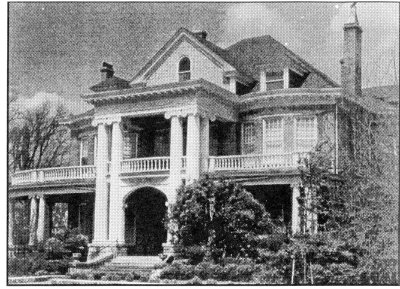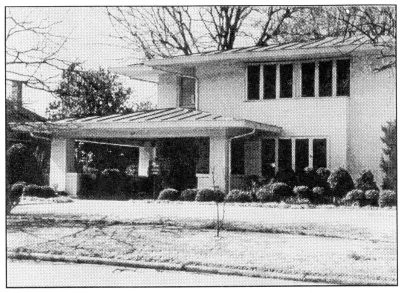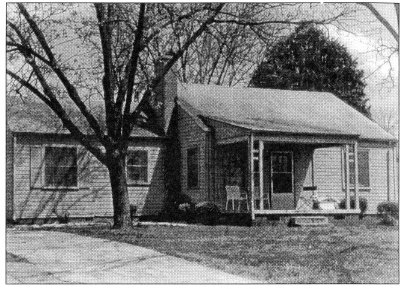Introduction
Harvie P. Jones turned his attention to distinctive architecture of all kinds and eras. His own architectural practice encompassed contemporary buildings in contemporary styles as well as historic preservation.
In 1985, he attempted to "whet our interest" in Huntsville's 20th century houses. His article, initially published in the Historic Huntsville Review (reprinted with permission of the Huntsville-Madison County Historical Society), surveys these relatively recent buildings from a late-20th century vantage point, as he noted, "only about 15 years" from the century's end (Historic Huntsville Quarterly, Vol. XI, Nos. 2 & 3, Winter/Spring, 1985).
In the last years of the century, his comments are still valid. Harvie cast his remarks in the form of a brief introductory overview followed by a "picture story" of interesting examples. From his vast files of photographs, we located Harvie's original black and white photographs so that the images would be as clear as possible.
In September 1998, when Harvie was reviewing the picture captions he had written thirteen years earlier, he noted "Almost every caption begins with 'this.' Too bad, but no editor was available to point out this stylistic defect." For this republication of Harvie's article. Historic Huntsville Quarterly Editor Margaret J. Vann has made the changes Harvie would have wanted.
Harvie's picture story is especially rich in its consideration of bungalows, that quintessentially 20th century American building type. Many readers have had some experience with bungalows, for they are found across America at every income level and in every geography. Harvie's appreciation of bungalows is infectious: an article on a mid-century Madison County bungalow will be featured in a forthcoming issue of Historic Huntsville Quarterly.
The turn of the 20th century found several styles of residential architecture being built in Huntsville, including late-Victorian versions of Eastlake and Queen Anne. As a result of the 1876 National Centennial celebrations Colonial Revival was also an influence. These influences were sometimes freely intermingled in a Free Classical style as in the 1902 Van Valkenburgh house at 501 Franklin Street and Williams Avenue. Within the first decade of the century, a number of houses - frequently fine examples designed by architects - of the Bungalow style were built. By the 1920s, the Bungalow style had become the predominant one for houses, and it even had an influence on larger buildings such as Rison School and the YMCA on Greene Street. By the 1920s, surviving Huntsville houses indicate that the major house styles were Bungalow, Tudor or English Cottage, and Colonial Revival, with a few examples of Spanish Colonial Revival and other styles.
The word bungalow is rooted in the Bengali (India) word bangala that denoted the typical 17th century native dwelling of that region of India (Winter 19). Historic drawings indicate that a bangala had wide, low, spreading hipped roofs covering open verandahs surrounding the enclosed part of the dwelling. The English in India adopted both the word and the dwelling type as an actual and a symbolic retreat to the simple rural life. The type was eventually transplanted to England and then to America with its symbolism, if not its pure form, intact: a return to the simple, rural life (even when built in rows in streetcar subdivisions). The architectural historian Clay Lancaster found the first known American reference to the word bungalow in an 1880 issue of American Architect and Building News regarding a Cape Cod summer place (Winter 21). Perhaps due to its symbolism, the bungalow found enormous popularity in newly-developed California. Hundreds of "bungalow books" - stock designs - were published, and the style became popular nationwide. Regional types developed, such as the Prairie Style in the Chicago area (Huntsville has two examples of this house style).
The dominant expression of the bungalow is one of easy informality. Remarkably, this comes across whether the bungalow is large or small, expensive or cheap. The means of expression is the use of irregular low spreading forms with wide, exposed-rafter roof eaves, usually half-timbered roughcast stuccoed walls, large porches, bay windows, etc. The roof usually slopes down to the front to keep the form low. Sunlight picks out the dot-dot-dot rhythm of the rafter ends and highlights the texture of the rough stucco and the deep shadow of the wide porch.
The bungalow's strongest period here was the 1920s, until the 1929 financial crash brought a halt to virtually all construction. The next significant period of residential construction in Huntsville was in the early 1940s when hundreds of small Cape Cod Cottages were built to house workers for the new Redstone and Huntsville Arsenals that were producing chemical warfare munitions in World War II. These houses were covered with cement-asbestos shingles or clapboards and had a simple rectangular gabled form without roof eaves. They were fast and economical to build, which was what was needed at the time.
This type persisted after World War II until the type the real estate ads call Ranch-Colonial became strong in the 1960s. With occasional exceptions, the Ranch-Colonial is the type still most commonly built today. It combines the informality and low rambling form found desirable in the bungalow, with the tradition, reserve and formality of classicism. Its classical ancestor is the architecture of Andrea Palladio, the 16th century Italian architect. Many of the Ranch-Colonial houses are, except for their low, spreading proportions, very similar to the porticoed, hipped-roofed 16th century villa designs of Palladio. Palladio's work was revived in England in the early 18th century and his 1570 book The Four Books Of Architecture was republished and had a great influence in England and, consequently, in the American colonies. The Georgian and Federal period American architecture owes much to Palladio(as well as to the Baroque period in the case of Georgian and to the work of the 18th century English architect Robert Adam in the case of Federal). Many of the Tuscan-porticoed 1960-1985 Huntsville houses could fairly be called Ranch Palladian (see Fig. 14, page 31).
Huntsville has a wide variety of 20th century houses that will become even more interesting to us as we realize that the 20th century is now drawing to a close (only about fifteen years remain in the 20th century). It is time we study them more seriously. Perhaps this brief overview will help whet our interest.
Bibliography
Brooks, H. Allen. The Prairie School. Toronto: U. of Toronto Press, 1972.
Smith, G.E. Kidder. Switzerland Builds. Stockholm: Ahlen & Akerlunds, 1950.
Winter, Robert. The California Bungalow. Los Angeles: Hennessy &Ingalls, Inc., 1980.
Credits:
Historical data on individual structures (dates, architect, contractor) are from the City of Huntsville Planning Department, Linda Bayer Allen, Historical Planner. All photographs were taken by Harvie P. Jones, FAIA.













